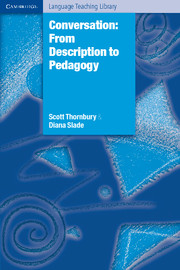Book contents
- Frontmatter
- Contents
- Thanks and acknowledgements
- Dedication
- Introduction
- 1 Characterizing conversation
- 2 The vocabulary of conversation
- 3 The grammar of conversation
- 4 The discourse features of conversation
- 5 Genres in conservation: Storytelling and gossiping
- 6 Acquiring L1 conversational competence
- 7 Acquiring L2 conversational competence
- 8 Teaching conversation: A history
- 9 Teaching conversation: Approach, design, procedure and process
- Task key
- References
- Author index
- Subject index
9 - Teaching conversation: Approach, design, procedure and process
Published online by Cambridge University Press: 04 May 2010
- Frontmatter
- Contents
- Thanks and acknowledgements
- Dedication
- Introduction
- 1 Characterizing conversation
- 2 The vocabulary of conversation
- 3 The grammar of conversation
- 4 The discourse features of conversation
- 5 Genres in conservation: Storytelling and gossiping
- 6 Acquiring L1 conversational competence
- 7 Acquiring L2 conversational competence
- 8 Teaching conversation: A history
- 9 Teaching conversation: Approach, design, procedure and process
- Task key
- References
- Author index
- Subject index
Summary
Introduction
In the previous chapter we traced the history of the teaching of conversation up to the present day. In this history several key themes have surfaced repeatedly. For a start, the term conversation has been used at one time or another to embrace everything from controlled oral practice to uncontrolled chat, and the finer distinctions between dialogue, discussion, debate, free speaking, role play and casual conversation have been consistently blurred. As we attempted to show in Chapters 1 to 5, while conversation as a form of spoken language can incorporate a range of sub-genres, it can nevertheless be fairly narrowly defined in terms both of its purposes and of its characteristic features. As awareness of these purposes and features has grown, it has become no longer viable simply to treat conversation as synonymous with speaking.
Even when the term is used more precisely – to mean something like ‘informal talk among friends’ – conversation has for the most part been treated as a curricular ‘add-on’. At times, in fact, it has been actively discouraged in classrooms. Only sporadically has it been highly prioritized, either as a primary learning objective, or, even, as the means by which language learning itself might best be achieved.
In this chapter we outline, in broad strokes, the pedagogical options available to teachers who have chosen to include the teaching of conversation as a curricular objective. The strokes are necessarily broad because no single approach to teaching conversation will be appropriate or even practicable in all teaching situations. Different configurations of context factors will determine the ultimate design and implementation of the program.
- Type
- Chapter
- Information
- ConversationFrom Description to Pedagogy, pp. 274 - 325Publisher: Cambridge University PressPrint publication year: 2006
- 1
- Cited by



